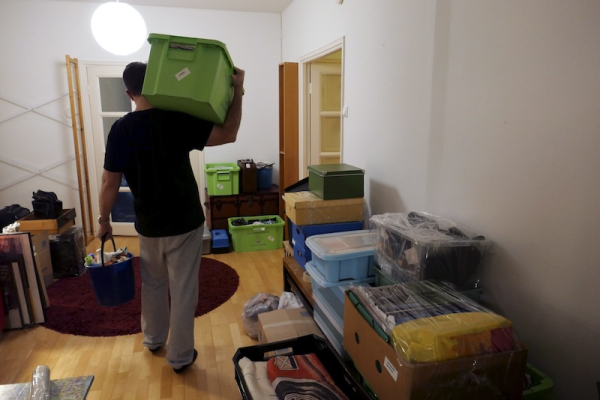Yle: Residents leaving state-backed housing – Finland prepares to scale down ASO system

Man moving in Helsinki. Photo: Liisa Halkosaari / Lehtikuva
- Next Article Foreign tech professionals in Finland face worsening prospects
Finland’s right-of-occupancy housing system is facing a sharp decline in popularity and growing financial risk, prompting the state to end new project subsidies and launch legal reforms aimed at limiting its exposure.
According to reporting by Yle, more than 100,000 people currently live in right-of-occupancy (ASO) homes, a model offering tenants long-term housing without full ownership. But demand has plummeted, vacancies are rising, and the number of terminated ASO contracts increased by over 70 per cent between 2023 and 2024.
Eric Hällström, honorary chair of the Finnish Right-of-Occupancy Residents’ Association (SASO), said an exodus is under way. “You can see it clearly. A moving truck is often parked outside the buildings,” Hällström told Yle.
In 2024, empty ASO units more than tripled compared to the previous year. Simultaneously, construction peaked, driven by a final wave of projects launched before the state cut off financial support. All new subsidy applications had to be filed by the end of 2023.
Around 10 per cent of ASO flats are now held by the housing companies themselves due to lack of tenants, and many are rented out through the open market.
In Jyväskylä alone, 200 ASO apartments are currently under construction, double the usual annual volume.
The Ministry of the Environment commissioned a review which concluded that ending state aid effectively halts all future ASO development. Without new builds to help balance costs, maintenance charges, called “vastikkeet”, are expected to rise.
Tenants are already reacting. With private market rents falling and ASO charges increasing, many are choosing to leave. Some fear they won’t recover the initial entry payment, usually 15 per cent of the unit’s value, if the housing company’s financial position weakens.
Those concerns intensified after housing developer Lakea’s projects, operating under a different ownership model, entered bankruptcy proceedings. While ASO and Lakea’s “Omaksimalli” differ legally, both require upfront payments and face similar risks.
“There can be unexpected financial problems in these companies that push them into insolvency. This risk exists for ASO companies as well,” said Hällström.
The government’s exposure is significant. The state has roughly €6 billion in loans and guarantees tied to the ASO stock. To reduce this liability, the Ministry of the Environment is preparing legislation that could change the system’s structure.
One planned reform would allow ASO contracts to include termination clauses for severely underused properties. Another would introduce a “realisation model,” enabling the sale of ASO properties if housing security is at risk, essentially, when bankruptcy looms.
In parallel, a mechanism is being considered to allow current residents to buy their ASO homes outright.
For some, these reforms are worrying.
Hällström argues they would weaken the legal security of ASO residents and push them into the same position as standard renters. “We’re talking about assets worth €5–10 billion. These homes have been largely paid off. The prospect of selling them off is understandably attractive to whoever gets that chance,” he said.
TA-Asumisoikeus, Finland’s second-largest ASO provider, downplayed the risks. Its CEO Esa Mustonen told Yle that ASO companies are non-profit entities, prohibited from distributing profits to owners.
“I find it hard to believe any company would aim for insolvency just to sell assets,” Mustonen said.
Mustonen acknowledged that if demand collapses, any company would face difficulty. “Of course, if customers stop using the service entirely, that’s a problem for any business.”
The system’s rigidity is also under scrutiny. Under current law, ASO residents have lifelong housing rights. As a result, buildings cannot be sold off even if occupancy drops significantly. Furthermore, ASO flats are rarely accepted by banks as collateral, reducing financial flexibility for both residents and companies.
The ministry’s plan would allow for broader options, including property sales in crisis scenarios. The state hopes to prevent a situation where falling demand, rising vacancies, and mass refund payments trigger liquidity shortages and defaults.
“If even one ASO company went bankrupt, it would affect the entire system,” said Anu Karjalainen, legal advisor at the Ministry of the Environment.
Despite the risks, supporters argue that the non-profit nature and scale of providers like TA help spread the burden. Still, concerns remain that any perception of instability could drive more tenants away, further accelerating the cycle.
Article based on material from Yle.
HT
- Next Article Foreign tech professionals in Finland face worsening prospects
Source: www.helsinkitimes.fi
